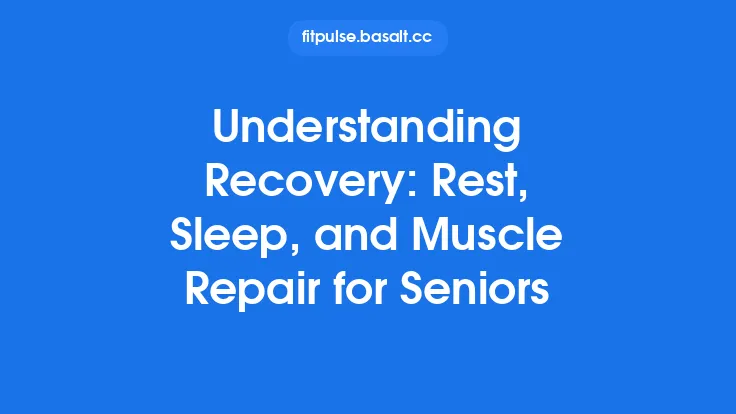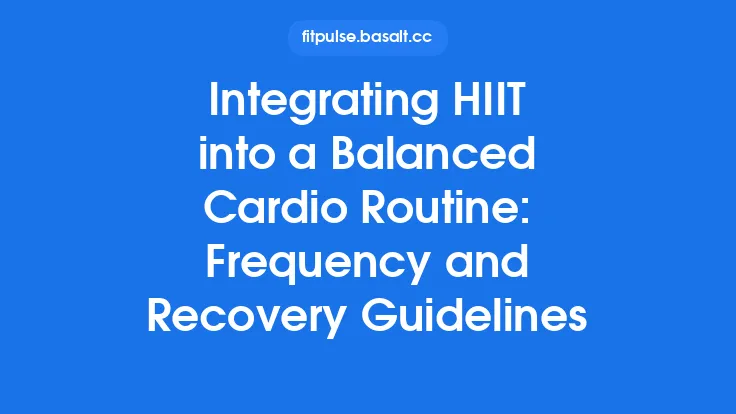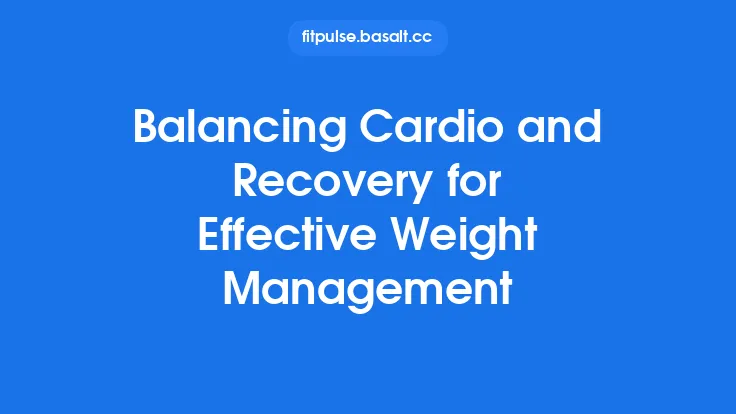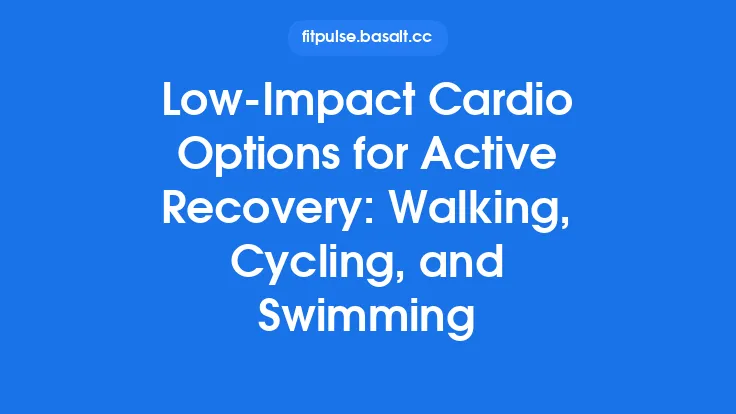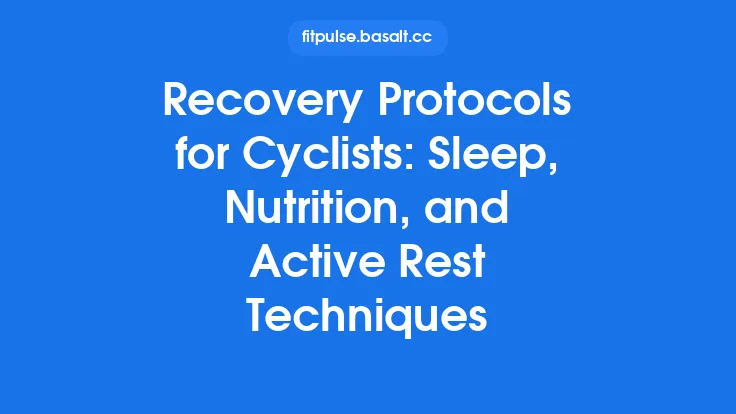Low‑intensity steady‑state (LISS) cardio is often celebrated for its fat‑burning potential and cardiovascular benefits, but its role in the recovery phase of a training program is equally compelling. When incorporated thoughtfully, LISS can accelerate muscle repair, diminish delayed‑onset muscle soreness (DOMS), and help athletes return to peak performance more quickly. This article explores the science behind those recovery‑enhancing effects and offers practical guidance on how to use LISS as a dedicated recovery tool without overlapping with broader training design or safety considerations.
Why Active Recovery Beats Complete Rest
Complete inactivity after a demanding workout may feel intuitive, yet research consistently shows that low‑intensity movement promotes a more efficient recovery cascade. The primary reasons are:
- Enhanced Blood Flow – Gentle aerobic activity raises cardiac output modestly, increasing perfusion to skeletal muscle. This delivers oxygen and nutrients while facilitating the removal of metabolic by‑products such as lactate, hydrogen ions, and inflammatory cytokines.
- Accelerated Metabolite Clearance – LISS stimulates the lymphatic system, which, together with the circulatory system, helps clear interstitial fluid that can accumulate after intense resistance training. Faster clearance reduces swelling and the sensation of stiffness.
- Modulation of Inflammatory Signaling – Low‑intensity exercise triggers the release of anti‑inflammatory cytokines (e.g., IL‑10) and reduces pro‑inflammatory markers (e.g., TNF‑α). This shift supports the transition from the catabolic phase of muscle damage to the anabolic rebuilding phase.
- Neuromuscular Re‑education – Light movement maintains motor unit firing patterns, preventing the temporary loss of proprioceptive acuity that can accompany prolonged bed rest.
Collectively, these mechanisms make LISS a potent active‑recovery modality that can be strategically placed after heavy lifting sessions, high‑intensity interval training, or competition days.
Physiological Mechanisms Behind LISS‑Facilitated Muscle Repair
1. Mitochondrial Biogenesis and Energy Re‑synthesis
During high‑intensity work, muscle glycogen stores are depleted and phosphocreatine (PCr) reserves are exhausted. LISS, performed at ~40‑55 % of VO₂max, primarily utilizes oxidative phosphorylation, prompting mitochondria to ramp up ATP production. This not only replenishes PCr but also stimulates the expression of peroxisome proliferator‑activated receptor‑γ coactivator‑1α (PGC‑1α), a master regulator of mitochondrial biogenesis. More robust mitochondria improve the muscle’s capacity to handle oxidative stress and support protein synthesis pathways essential for repair.
2. Hormonal Environment
Low‑intensity aerobic work elicits a modest increase in circulating catecholamines (epinephrine, norepinephrine) without the cortisol spikes seen in high‑intensity bouts. The net hormonal milieu favors an anabolic state: insulin sensitivity improves, facilitating glucose uptake into muscle cells, while growth‑factor signaling (e.g., IGF‑1) remains unperturbed. This environment is conducive to muscle protein synthesis (MPS) during the post‑exercise window.
3. Myokine Release
Skeletal muscle acts as an endocrine organ, releasing myokines such as irisin and brain‑derived neurotrophic factor (BDNF) during contraction. LISS stimulates a steady, low‑amplitude release of these factors, which have been linked to enhanced satellite‑cell activation—a critical step in repairing micro‑tears in muscle fibers.
4. pH Regulation and Lactate Shuttling
Lactate produced during intense training is not merely a waste product; it serves as a gluconeogenic substrate and an oxidative fuel for the heart and slow‑twitch fibers. LISS promotes the conversion of lactate back to pyruvate via the lactate dehydrogenase (LDH) reaction, helping restore intracellular pH and providing an additional energy source for recovery processes.
Optimal Intensity and Duration for Recovery Sessions
While “low‑intensity” can be subjective, the following parameters have emerged as reliable guidelines for recovery‑focused LISS:
| Parameter | Recommended Range | Rationale |
|---|---|---|
| Heart Rate | 50‑65 % of maximum heart rate (MHR) or 40‑55 % of VO₂max | Ensures aerobic metabolism predominates without inducing additional muscular fatigue. |
| Perceived Exertion | 2‑3 on the Borg Scale (0‑10) | Keeps effort low enough to avoid triggering catabolic stress. |
| Duration | 15‑30 minutes per session | Sufficient to boost circulation and metabolite clearance without depleting glycogen further. |
| Frequency | 1‑2 sessions on recovery days (e.g., after heavy leg day or competition) | Provides consistent recovery stimulus while allowing full rest on other days. |
A practical example: a 30‑minute brisk walk at a pace that allows comfortable conversation, maintaining a heart rate around 110‑130 bpm for a 30‑year‑old recreational lifter.
Choosing the Right Modality for Post‑Workout Recovery
Although the article’s scope excludes a deep dive into modality selection, a brief overview helps align the recovery goal with the activity:
- Walking – Ideal for most athletes; low joint impact, easy to regulate intensity, and readily accessible.
- Stationary Cycling (low resistance) – Provides a seated option that reduces load on the spine and lower extremities while still delivering leg‑specific circulation.
- Elliptical (low stride) – Offers a full‑body motion with minimal eccentric loading, useful for upper‑body recovery days.
- Aquatic Walking or Light Swimming – Water buoyancy further reduces mechanical stress, making it suitable for individuals with acute soreness or minor joint irritation.
The key is to select a modality that maintains the prescribed intensity range without introducing new sources of muscular strain.
Integrating LISS into Your Recovery Protocol
- Timing
- Immediate Post‑Exercise: Within 30 minutes after the primary training session, perform a brief (5‑10 minute) low‑intensity cool‑down to transition from high‑intensity work to recovery LISS.
- Dedicated Recovery Day: Schedule a standalone LISS session on the day following a heavy training block, preferably after a light mobility routine.
- Sequencing with Stretching
- Perform dynamic mobility drills (e.g., leg swings, arm circles) before LISS to prime the muscles.
- Follow the LISS session with static stretching or foam‑rolling to further promote tissue extensibility and reduce residual tension.
- Periodization Considerations
- During high‑volume training phases (e.g., hypertrophy blocks), increase the frequency of LISS recovery sessions to 2‑3 per week.
- In taper weeks leading up to competition, maintain a single 15‑minute LISS session to preserve circulation without adding fatigue.
Nutritional Synergy with LISS Recovery
The physiological benefits of LISS are amplified when paired with targeted nutrition:
- Carbohydrate Replenishment – Consuming 0.5‑0.7 g/kg of high‑glycemic carbs within the first hour post‑LISS helps restore glycogen stores depleted during the primary workout, ensuring energy availability for repair processes.
- Protein Timing – A 20‑30 g dose of high‑quality protein (e.g., whey, soy, or a mixed plant blend) taken alongside carbs stimulates muscle protein synthesis, leveraging the insulin response triggered by the carbohydrate intake.
- Hydration and Electrolytes – Low‑intensity cardio promotes continued sweating; replenishing sodium, potassium, and magnesium supports cellular fluid balance and reduces cramping risk.
- Anti‑Inflammatory Nutrients – Omega‑3 fatty acids (EPA/DHA) and polyphenol‑rich foods (berries, tart cherry juice) can complement the anti‑inflammatory cascade initiated by LISS.
Monitoring Recovery Progress and Making Adjustments
Even though the article avoids detailed effort‑monitoring tools, a few simple, evergreen strategies can help gauge whether LISS is delivering the desired recovery outcomes:
- Subjective Soreness Scale – Rate muscle soreness on a 0‑10 scale before and after LISS sessions. A consistent reduction of 1‑2 points over a week suggests effective recovery.
- Performance Metrics – Track key lifts or sprint times across training cycles. If performance stabilizes or improves while maintaining LISS recovery, the protocol is likely beneficial.
- Resting Heart Rate (RHR) – A downward trend in morning RHR can indicate improved autonomic balance and recovery status.
- Sleep Quality – Use a sleep journal or basic wearable data to note any improvements in sleep latency or duration after incorporating LISS; better sleep further enhances muscle repair.
If soreness persists or performance declines, consider adjusting one of the following variables: reduce session duration, lower intensity slightly, or increase the interval between the primary workout and the LISS session.
Common Misconceptions About LISS and Recovery
| Misconception | Reality |
|---|---|
| “LISS burns the same calories as HIIT, so it’s equally effective for fat loss during recovery.” | While LISS does expend calories, its primary recovery value lies in circulation and inflammation control, not maximal caloric burn. |
| “Any low‑intensity activity will work; intensity doesn’t matter.” | Too low an intensity (e.g., strolling at a leisurely pace) may not sufficiently raise blood flow, while too high an intensity can re‑induce fatigue. Staying within the 50‑65 % MHR window is crucial. |
| “You must do LISS every day to see benefits.” | Over‑doing any cardio can interfere with muscle adaptation. Targeted, strategic sessions (1‑2 per week) are sufficient for recovery. |
| “LISS replaces the need for proper rest and sleep.” | LISS is a complementary tool; it cannot substitute the hormonal and cellular restoration that occurs during quality sleep. |
| “You can perform LISS immediately after a heavy strength session without any warm‑up.” | A brief cool‑down and mobility work before LISS helps transition the body safely and maximizes blood flow to the targeted muscles. |
Bottom Line
Low‑intensity steady‑state cardio, when applied with a recovery‑first mindset, becomes a powerful ally in the quest for faster muscle repair and reduced soreness. By leveraging its ability to enhance circulation, modulate inflammation, and create a favorable hormonal environment, athletes can accelerate the transition from muscle damage to rebuilding. Pairing LISS with appropriate nutrition, timing, and simple monitoring ensures that the recovery benefits are both measurable and sustainable, allowing you to train harder, more frequently, and with less lingering discomfort.

